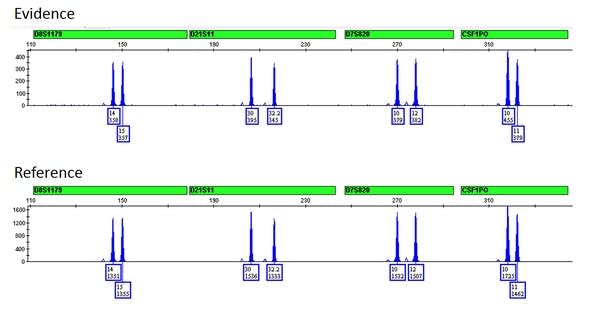It's a match. Or is it?
DNA analysis has come to be one of the most relied-upon tools in forensic criminology. Here's a look at when it's simple and when it's not.

DNA analysis can be one of the most reliable ways to trace a crime to its perpetrator. As the technology advances, scientists are interpreting smaller, more complicated samples of DNA than ever before. But this means that in some cases the risk of getting it wrong grows, and a once-objective process takes a turn for the subjective.
The graph above shows two samples an analyst would compare. The top image represents a sample that might be taken from a crime scene. The bottom image, called a "reference" sample, is taken from blood, saliva or other material from a potential suspect. To simplify matters, we've zoomed in on four of the 16 markers that analysts examine on a DNA strand. The peaks are called alleles, and a typical person has two at each marker, one from each parent.

In this case, it's clearly a match. The samples line up visually, and the numbers that uniquely identify each allele — 14 and 15, 30 and 32.2, 10 and 12, 10 and 11 — are the same.
"This is where DNA has the reputation of being the gold standard," said Dr. Michael Coble, a forensic biologist at the National Institute of Standards and Technology. He created these graphs for APM Reports to demonstrate DNA analysis. They did not come from crime scene evidence.
"There's really no ambiguity here," Coble said. "The blood evidence or whatever type of evidence you're looking at came from a single individual, and you're comparing that to the reference of a single individual."
In the field, though, DNA collected from a crime scene isn't always so pristine. This is where it starts to get complicated.
"DNA evidence is not always in high quantity and high quality," Coble said. "DNA may be degraded. It may be compromised. It could be a mixture."

This second image shows a sample of DNA evidence from several people, again with a reference sample from a potential suspect below. Since there are five peaks at one location, noted by the blue arrow, and most people have only two, analysts would conclude that this sample must contain DNA from at least three people.
But if there are three people in the mixture, there should be six peaks at each marker. That points to another problem with the sample: dropout. The peaks are alarmingly uneven, and it becomes apparent that some are weak or missing entirely.
"You can see that the reference profile (the lower graph) has a 12 allele and a 14 allele," Coble said of the far left marker. The red arrow shows where that 12 allele should be in the crime scene sample. "The amount of DNA from this particular individual was so low that this 12 allele did not get amplified, so it's missing."
The same is true for the next marker over — an arrow points out where a 16 allele should be.
Of course, Coble had the advantage of knowing which alleles are missing because he knows the three DNA profiles used to create this sample. In a real analysis, he would have a hard time determining if the reference was indeed one of the three contributors to this DNA mixture. He would call it inconclusive, meaning he couldn't rule the person in or out. "Even though there's instances where dropout has occurred, he's still there," Coble said. "At least, half of him looks to be there."
Coble said scientists have to make a judgment call in cases like this one. Some labs would probably throw out this sample, while others might try to identify the major contributor.
"This is where the complexity starts to go up and up and up, when you're doing these types of really difficult mixtures and you've got some data that's missing," he said. "And so this is where it starts to become really hairy."